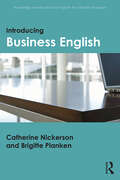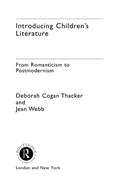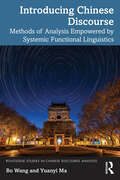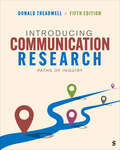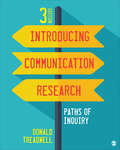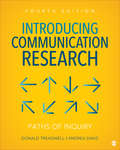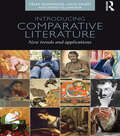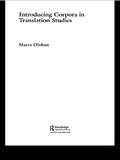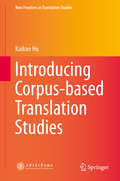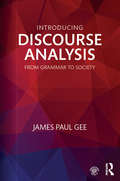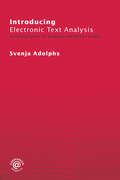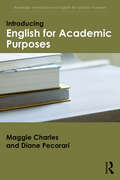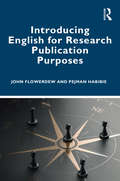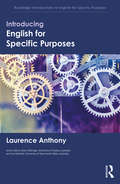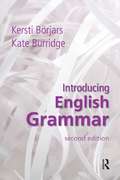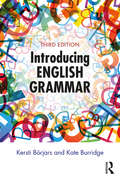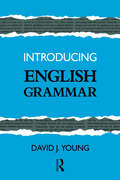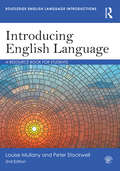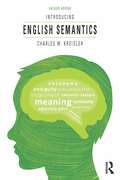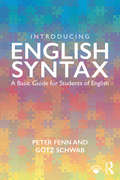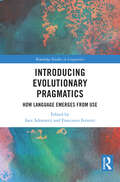- Table View
- List View
Introducing Business English (Routledge Introductions to English for Specific Purposes)
by Catherine Nickerson Brigitte PlankenIntroducing Business English provides a comprehensive overview of this topic, situating the concepts of Business English and English for Specific Business Purposes within the wider field of English for Special Purposes. This book draws on contemporary teaching and research contexts to demonstrate the growing importance of English within international business communication. Covering both spoken and written aspects of Business English, this book: examines key topics within Business English, including teaching Business English as a lingua franca, intercultural business interactions, blended learning and web-based communication; discusses the latest research on each topic, and possible future directions; features tasks and practical examples, a section on course design, and further resources. Written by two leading researchers and teachers, Introducing Business English is a must-read for advanced undergraduate and postgraduate students studying Business English, Business English as a Lingua Franca, and English for Specific Business Purposes.
Introducing Children's Literature: From Romanticism to Postmodernism
by Deborah Cogan Thacker Jean WebbIntroducing Children's Literature is an ideal guide to reading children's literature through the perspective of literary history. Focusing on the major literary movements from Romanticism to Postmodernism, Thacker and Webb examine the concerns of each period and the ways in which these concerns influence and are influenced by the children's literature of the time. Each section begins with a general chapter, which explains the relationship between the major issues of each literary period and the formal and thematic qualities of children's texts. Close readings of selected texts follow to demonstrate the key defining characteristics of the form of writing and the literary movements. Original in its approach, this book sets children's literature within the context of literary movements and adult literature. It is essential reading for students studying writing for children. Books discussed include: *Louisa May Alcott's Little Women* Charles Kingsley's The Water-Babies *Lewis Carroll's Alice in Wonderland*Frank Baum's The Wizard of Oz*Frances Hodgson Burnett's The Secret Garden*P.L.Travers' Mary Poppins*E.B.White's Charlotte's Web*Philip Pullman's Clockwork.
Introducing Chinese Discourse: Methods of Analysis Empowered by Systemic Functional Linguistics (Routledge Studies in Chinese Discourse Analysis)
by Bo Wang Yuanyi MaDrawing on Systemic Functional Linguistics (SFL), this book introduces readers to the methods for analysing discourse/texts written and spoken in the Chinese language. It presents Chinese discourse as a semantic unit, adopting a trinocular view in terms of the hierarchy of stratification. The texts in this book are based on a comprehensive and rich archive, featuring not only text types available in other languages and cultures, but also those unique in the Chinese language. The book is aimed at students and researchers working on SFL, language description, translation studies or related areas, as well as MA or doctoral students who have some basic knowledge about linguistics or discourse analysis.
Introducing Communication Research: Paths of Inquiry
by Donald TreadwellIntroducing Communication Research: Paths of Inquiry teaches students the basics of communication research in an accessible manner by using student-focused real-world examples, engaging application exercises, and up-to-date resources. Donald Treadwell guides readers through the process of conducting communication research and presenting findings for a diversity of audiences, and the book emphasizes the Internet and social media as both topics of, and tools for, communication research. The Fifth Edition adds new pedagogical features, a new social media and big data section in each method chapter, coverage throughout of the impact of artificial intelligence (AI) and particularly in relation to reporting and presenting research; and references the latest research and data sources related to changes in communication brought about by the COVID-19 pandemic. Included with this title: LMS Cartridge: Import this title’s instructor resources into your school’s learning management system (LMS) and save time. Don′t use an LMS? You can still access all of the same online resources for this title via the password-protected Instructor Resource Site. Learn more.
Introducing Communication Research: Paths of Inquiry
by Donald TreadwellIntroducing Communication Research: Paths of Inquiry teaches students the basics of communication research in an accessible manner by using student-focused real-world examples, engaging application exercises, and up-to-date resources. Donald Treadwell guides readers through the process of conducting communication research and presenting findings for a diversity of audiences, and the book emphasizes the Internet and social media as both topics of, and tools for, communication research. The Fifth Edition adds new pedagogical features, a new social media and big data section in each method chapter, coverage throughout of the impact of artificial intelligence (AI) and particularly in relation to reporting and presenting research; and references the latest research and data sources related to changes in communication brought about by the COVID-19 pandemic. Included with this title: LMS Cartridge: Import this title’s instructor resources into your school’s learning management system (LMS) and save time. Don′t use an LMS? You can still access all of the same online resources for this title via the password-protected Instructor Resource Site. Learn more.
Introducing Communication Research: Paths of Inquiry
by Donald F. TreadwellIntroducing Communication Research: Paths of Inquiry helps students understand the communication research process from start to finish. The Third Edition has been updated throughout to explain the Internet and social media as tools and topics for communication research. Streamlined, accessible, and with campus-based research examples that students can relate to, this text guides students through the fundamentals of conducting research and presenting research findings for scholarly, professional, news/media, and web audiences.
Introducing Communication Research: Paths of Inquiry
by Donald F. Treadwell Andrea DavisIntroducing Communication Research: Paths of Inquiry, Fourth Edition demystifies the theories and applications of communication research through its focus on methods in practice. Offering an overview of the research process with a focus on examples of research in real-world settings, Donald Treadwell and Andrea Davis introduce both quantitative and qualitative methods.
Introducing Communication Research: Paths of Inquiry
by Donald F. Treadwell Andrea DavisIntroducing Communication Research: Paths of Inquiry, Fourth Edition demystifies the theories and applications of communication research through its focus on methods in practice. Offering an overview of the research process with a focus on examples of research in real-world settings, Donald Treadwell and Andrea Davis introduce both quantitative and qualitative methods.
Introducing Comparative Literature: New Trends and Applications
by Haun Saussy César Domínguez Darío VillanuevaIntroducing Comparative Literature is a comprehensive guide to the field offering clear, concise information alongside useful analysis and examples. It frames the introduction within recent theoretical debates and shifts in the discipline whilst also addressing the history of the field and its practical application. Looking at Comparative Literature within the context of globalization, cosmopolitanism and post or transnationalism, the book also offers engagement and comparison with other visual media such as cinema and e-literature. The first four chapters address the broad theoretical issues within the field such as 'interliterary theory', decoloniality, and world literature, while the next four are more applied, looking at themes, translation, literary history and comparison with other arts. This engaging guide also contains a glossary of terms and concepts as well as a detailed guide to further reading.
Introducing Corpora in Translation Studies
by Maeve OlohanThe use of corpora in translation studies, both as a tool for translators and as a way of analyzing the process of translation, is growing. This book provides a much-needed assessment of how the analysis of corpus data can make a contribution to the study of translation.Introducing Corpora in Translation Studies: traces the development of corpus methods within translation studies defines the types of corpora used for translation research, discussing their design and application and presenting tools for extracting and analyzing data examines research potential and methodological limitatis considers some uses of corpora by translators and in translator training features research questions, case studies and discussion points to provide a practical guide to using corpora in translation studies. Offering a comprehensive account of the use of corpora by today's translators and researchers, Introducing Corpora in Translation Studies is the definitive guide to a fast-developing area of study.
Introducing Corpus-based Translation Studies
by Kaibao HuThe book addresses different areas of corpus-based translation studies, including corpus-based study of translation features, translator's style, norms of translation, translation practice, translator training and interpreting. It begins by tracing the development of corpus-based translation studies and introducing the compilation of different types of corpora for translation research. The use of corpora in different research areas is then discussed in detail, and the implications and limitations of corpus-based translation studies are addressed. Featuring the use of figures, tables, illustrations and case studies, as well as discussion of methodological issues, the book offers a practical guide to corpus-based translation. It will be of interest to postgraduate students and professionals who are interested in translation studies, interpreting studies or computer-aided translation.
Introducing Course Design in English for Specific Purposes (Routledge Introductions to English for Specific Purposes)
by Lindy WoodrowIntroducing Course Design in English for Specific Purposes is an accessible and practical introduction to the theory and practice of developing ESP courses across a range of disciplines. The book covers the development of courses from needs analysis to assessment and evaluation, and also comes with samples of authentic ESP courses provided by leading ESP practitioners from a range of subject and global contexts. Included in this book are: The basics of ESP course design The major current theoretical perspectives on ESP course design Tasks, reflections and glossary to help readers consolidate their understanding Resources for practical ESP course development Examples of authentic ESP courses in areas such as business, aviation and nursing Introducing Course Design in English for Specific Purposes is essential reading for pre-service and in-service teachers, and students studying ESP and applied linguistics.
Introducing Discourse Analysis: From Grammar to Society
by James Paul GeeIntroducing Discourse Analysis: From Grammar to Society is a concise and accessible introduction by bestselling author, James Paul Gee, to the fundamental ideas behind different specific approaches to discourse analysis, or the analysis of language in use. The book stresses how grammar sets up choices for speakers and writers to make, choices which express, not unvarnished truth, but perspectives or viewpoints on reality. In turn, these perspectives are the material from which social interactions, social relations, identity, and politics make and remake society and culture. The book also offers an approach to how discourse analysis can contribute to lessening the ideological divides and echo chambers that so bedevil our world today. Organized in a user-friendly way with short numbered sections and recommended readings, Introducing Discourse Analysis is an essential primer for all students of discourse analysis within linguistics, education, communication studies, and related areas.
Introducing Electronic Text Analysis: A Practical Guide for Language and Literary Studies
by Svenja AdolphsIntroducing Electronic Text Analysis is a practical and much needed introduction to corpora – bodies of linguistic data. Written specifically for students studying this topic for the first time, the book begins with a discussion of the underlying principles of electronic text analysis. It then examines how these corpora enhance our understanding of literary and non-literary works. In the first section the author introduces the concepts of concordance and lexical frequency, concepts which are then applied to a range of areas of language study. Key areas examined are the use of on-line corpora to complement traditional stylistic analysis, and the ways in which methods such as concordance and frequency counts can reveal a particular ideology within a text. Presenting an accessible and thorough understanding of the underlying principles of electronic text analysis, the book contains abundant illustrative examples and a glossary with definitions of main concepts. It will also be supported by a companion website with links to on-line corpora so that students can apply their knowledge to further study. The accompanying website to this book can be found at http://www.routledge.com/textbooks/0415320216
Introducing English for Academic Purposes (Routledge Introductions to English for Specific Purposes)
by Maggie Charles Diane PecorariIntroducing English for Academic Purposes is an accessible and engaging textbook which presents a wide-ranging introduction to the field, covering the global and institutional position of EAP as well as its manifestations in classrooms and research contexts around the world. Each chapter provides: a critical overview introducing readers to theory- and research-informed perspectives; profiles of practice to guide readers in putting theory to use in real world contexts; tasks, reflection exercises and a glossary to help readers consolidate their understanding; an annotated further reading section with links to online resources to enable readers to extend their knowledge. Covering both theoretical and practical issues, Introducing English for Academic Purposes is essential reading for studentsof applied linguistics, and pre-service and in-service teachers of EAP.
Introducing English for Research Publication Purposes
by John Flowerdew Pejman HabibieThere has been growing scholarly research and interest in writing for academic publication over the past decade and the field of English for Research Publication Purposes (ERPP) has established itself as an important domain within English for Academic Purposes (EAP). This introductory volume provides a comprehensive view of what ERPP encompasses as a scholarly field, including its disciplinary boundaries, competing discourses within the field, research and practice paradigms, and future prospects for research and pedagogy in this field. The book portrays a multifaceted and nuanced picture of the discourses and discussions shaping and underlying ERPP as a scholarly field, focusing on key aspects of ERPP including: emergence and expansion of ERPP; key theoretical and methodological orientations framing ERPP research; writing for scholarly publication practices of EAL, Anglophone, and early-career scholars and graduate students; the pedagogy of ERPP and relevant international policies, practices, and initiatives; the advancement of digital technologies and the implications for ERPP; new directions in ERPP practice and research. This book is essential reading for students and scholars within the areas of applied linguistics, TESOL, and English for Academic Purposes.
Introducing English for Specific Purposes (Routledge Introductions to English for Specific Purposes)
by Laurence AnthonyIntroducing English for Specific Purposes presents the key concepts and practices of ESP in a modern, balanced, and comprehensive way. This book defines ESP and shows how the approach plays a crucial role in the world of English language teaching. Explaining how needs analysis, language and learning objectives, materials and methods, and evaluation combine to form the four main pillars of ESP, the book includes: practical examples that illustrate how the core theories and practices of ESP can be applied in real-world academic and occupational settings; discussion of some of the most hotly debated issues in ESP; insights on how ESP courses can be organized and integrated to form a complete program; reflection boxes, practical tasks, extension research questions, and resources for further reading in each chapter. Introducing English for Specific Purposes serves as an ideal textbook for graduate and advanced undergraduate students studying courses on English for Specific Purposes or English for Academic Purposes, as part of degrees in English for Specific Purposes, Education, ELT, Applied Linguistics, TESOL or TEFL. This comprehensive publication is also an invaluable reference resource for pre-service and in-service teachers of ESP, and for English program managers and administrators.
Introducing English Grammar
by Kersti Borjars Kate BurridgeAnswering key questions such as 'Why study grammar?' and 'What is standard English?', Introducing English Grammar guides readers through the practical analysis of the syntax of English sentences. With all special terms carefully explained as they are introduced, the book is written for readers with no previous experience of grammatical analysis. It is ideal for all those beginning their study of linguistics, English language or speech pathology, as well as students with primarily literary interests who need to cover the basics of linguistic analysis.The approach taken is in line with current research in grammar, a particular advantage for students who may go on to study syntax in more depth. All the examples and exercises use real language taken from newspaper articles, non-standard dialects and include excerpts from studies of patients with language difficulties. Students are encouraged to think about the terminology as a tool kit for studying language and to test what can and cannot be described using these tools.This new edition has been fully revised in line with recent research. There is a new chapter on World English, a new glossary and a free website with extensive further reading and answers to the exercises.
Introducing English Grammar (A\hodder Arnold Publication)
by Kersti Börjars Kate BurridgeIntroducing English Grammar introduces readers to the methodology and terminology needed to analyse English sentences. The approach taken is in line with current research in grammar, a particular advantage for students who may go on to study syntax in more depth. All the examples and exercises use real language taken from both standard and non-standard geographical areas and dialects, and include excerpts from Australian and British newspaper articles. Students are encouraged to think about the terminology as a tool kit for studying language and to test what can and cannot be described using these tools. This new edition has been fully updated and features: an expanded introduction; new texts and exercises that include data from social media; revised material on 'Grammar at work' and 'English worldwide'; more suggestions for further reading at the end of the book; a brand new companion website with extensive further reading and answers to the exercises, which can be found at www.routledge.com/cw/borjars. Written for readers with no previous experience of grammatical analysis, Introducing English Grammar is suited to anyone beginning a study of linguistics, English language or speech pathology, as well as to students whose interests are primarily literary but who need a better understanding of the structure of English.
Introducing English Grammar
by David J. YoungIntroducing English Grammar provides a basic grounding in English grammar, without going into too much detail or theory, and will lay the foundation for further grammatical studies. David Young presents English grammar in a coherent and lively way. He dispels the popular notion among students that grammar is simply a set of dreary rules and argues for the importance of grammar in describing the structure and function of language itself. Exercises are provided at the end of each chapter and the book includes integrated diagrams and a glossary of technical terms at the back of the book.
Introducing English Language: A Resource Book for Students (Routledge English Language Introductions)
by Peter Stockwell Louise MullanyRoutledge English Language Introductions cover core areas of language study and are one-stop resources for students. Assuming no prior knowledge, books in the series offer an accessible overview of the subject, with activities, study questions, sample analyses, commentaries and key readings – all in the same volume. The innovative and flexible ‘two-dimensional’ structure is built around four sections – introduction, development, exploration and extension – which offer self-contained stages for study. Each topic can also be read across these sections, enabling the reader to build gradually on the knowledge gained. Introducing English Language: is the foundational book in the Routledge English Language Introductions series, providing an accessible introduction to the English language contains newly expanded coverage of morphology, updated and revised exercises, and an extended Further Reading section comprehensively covers key disciplines of linguistics such as historical linguistics, sociolinguistics and psycholinguistics, as well as core areas in language study including acquisition, standardisation and the globalisation of English uses a wide variety of real texts and images from around the world, including a Monty Python sketch, excerpts from novels such as Virginia Woolf’s To the Lighthouse, and news items from Metro and the BBC provides updated classic readings by the key names in the discipline, including Guy Cook, Andy Kirkpatrick and Zoltán Dörnyei is accompanied by a website with extra activities, project ideas for each unit, suggestions for further reading, links to essential English language resources, and course templates for lecturers. Written by two experienced teachers and authors, this accessible textbook is an essential resource for all students of the English language and linguistics.
Introducing English Linguistics
by Charles F. MeyerAre you looking for a genuine introduction to the linguistics of English that provides a broad overview of the subject that sustains students' interest and avoids excessive detail? Introducing English Linguistics accomplishes this goal in two ways. First, it takes a top-down approach to language, beginning with the largest unit of linguistic structure, the text, and working its way down through successively smaller structures (sentences, words, and finally speech sounds). The advantage of presenting language this way is that students are first given the larger picture - they study language in context - and then see how the smaller pieces of language are a consequence of the larger goals of linguistic communication. Second, the book does not contain invented examples, as is the case with most comparable texts, but instead takes its sample materials from the major computerised databases of spoken and written English, giving students a more realistic view of language.
Introducing English Semantics
by Charles W. KreidlerIntroducing English Semantics, Second Edition is a practical introduction to understanding how meanings are expressed in the English language. Presenting the basic principles of the discipline of semantics, this newly revised edition explores the knowledge of language that speakers have which enables them to communicate - to express observations, opinions, intentions and the products of their imagination. The text emphasises pragmatic investigation with numerous illustrative examples of concepts and ample exercises to help students develop and improve their linguistic analysis skills. Introducing English Semantics: Discusses the nature of human language and how linguists categorise and examine it. Covers meanings expressed in English words, prefixes, suffixes and sentences. Examines such relations as synonymy, antonymy, hyponymy, ambiguity, implication, factivity, aspect, and modality Draws comparisons between English and other languages Illustrates the importance of 'tone of voice' and 'body language' in face-to-face exchanges and the role of context in any communication Contains a wealth of exercises and a glossary to clearly define all terminology This new edition includes expanded and updated textual exercises and a greater focus on compounds and other kinds of composite lexemes. Written in a clear and accessible style, Introducing English Semantics is an essential text for any student taking an introductory course in semantics.
Introducing English Syntax: A Basic Guide for Students of English
by Peter Fenn Götz SchwabIntroducing English Syntax provides a basic introduction to syntax for students studying English as a foreign language at university. Examining English phrase and sentence structure from a descriptive point of view, this book develops the reader’s understanding of the characteristic features of English sentence construction and provides the necessary theoretical apparatus for engaging with the language. Key features include: A unique framework combining theoretical and practical approaches to provide an insight into the intricacies of English syntax; An accessible and clear style which guides the learner through analysis, application and practical construction of sentences; A range of exercises at the end of each chapter and a brand new e-resource housing answers and commentaries to these exercises. This book requires no previous knowledge of linguistics and is essential reading for students and teachers of applied linguistics and EFL/ESL, as well as those who seek a basic grounding in English sentence structure.
Introducing Evolutionary Pragmatics: How Language Emerges from Use (Routledge Studies in Linguistics)
by Ines Adornetti and Francesco FerrettiThis collection highlights a range of perspectives on the emerging body of research on evolutionary pragmatics, expanding the borders of language evolution research and indicating exciting new directions for the future of the field.The volume adopts a broad view of pragmatics, providing a counterpoint to classical models of language evolution by exploring the ways in which the origins of language can be traced through the emergence of language structures from use in context. The book synthesizes different lines of inquiry, ranging from evolutionary linguistics to cognitive linguistics, philosophy, and cognitive pragmatics, among other fields, which foreground the impact of the environment on language and of language, through speaker use, on context. The volume is organized around three sections, each taking in turn a different dimension of evolutionary pragmatics research; the origins of language as seen in animal communication; a closer look at the use of language in interaction for the formation of communication channel and linguistic meaning; the role of cooperation and competition dynamics for the emergence of language structure.This book will be of particular interest to scholars in evolutionary linguistics, language origins, cognitive pragmatics, cognitive archaeology, and cognitive semiotics, as well as related areas in philosophy, psychology, and anthropology.
